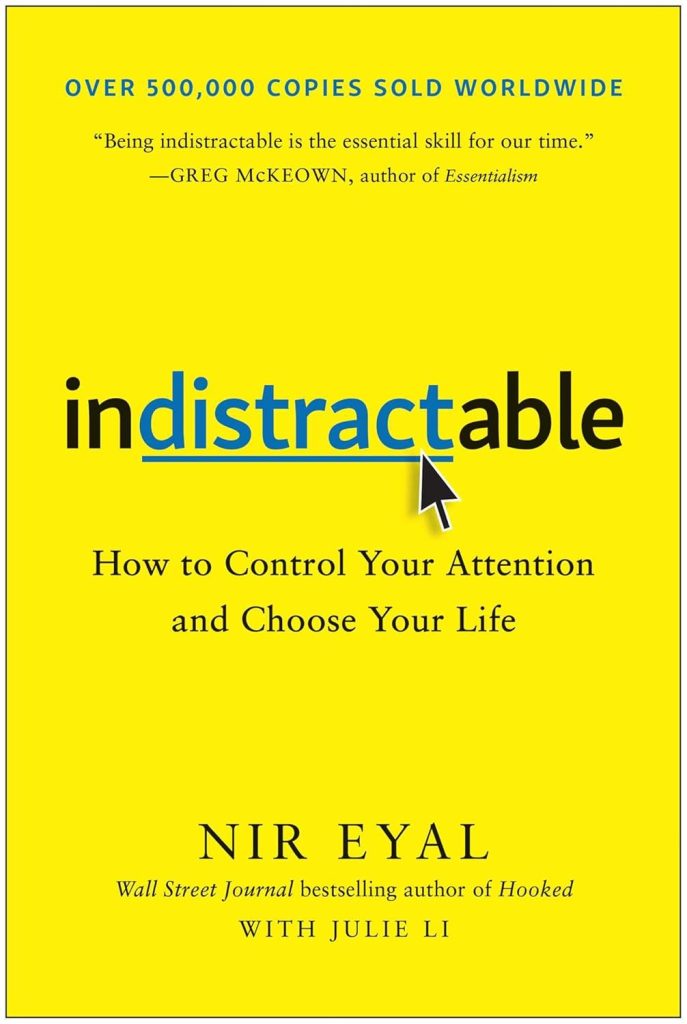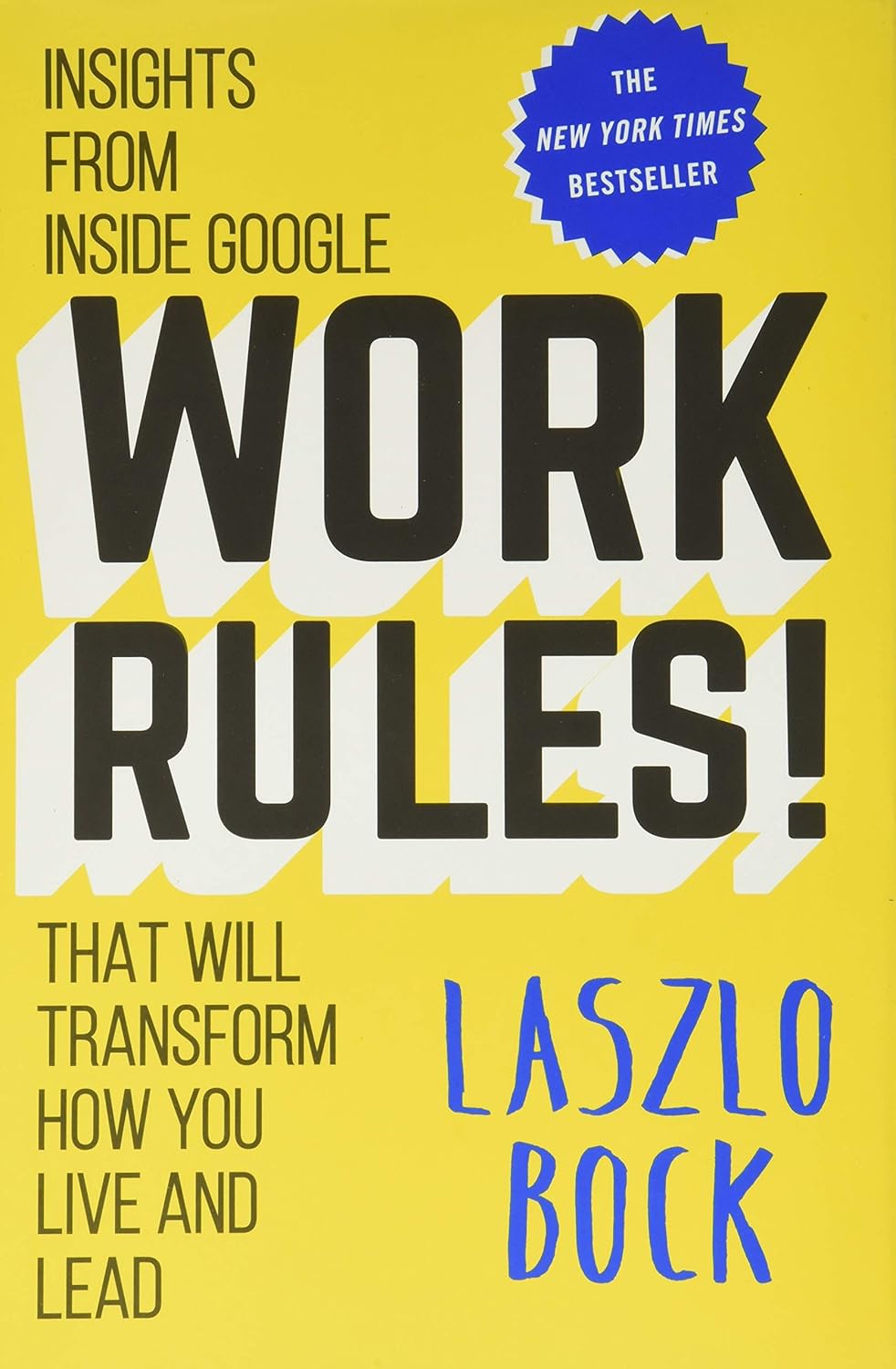
Buy The Book
Chapter
- ✦ Introduction: From Hooked to Indistractable
- ✦ Chapter 1: What’s Your Superpower?
- ✦ Chapter 2: Being Indistractable
- ✦ Part 1: MASTER INTERNAL TRIGGERS (Chapter 3-8)
- ✦ Part 2: MAKE TIME FOR TRACTION (Chapter 9-12)
- ✦ Part 3: HACK BACK EXTERNAL TRIGGERS (Chapter 13-21)
- ✦ Part 4: PREVENT DISTRACTION WITH PACTS (Chapter 22-25)
- ✦ Part 5: HOW TO MAKE YOUR WORKPLACE INDISTRACTABLE (Chapter 26-28)
- ✦ Part 6: HOW TO RAISE INDISTRACTABLE CHILDREN (Chapter 29-33)
- ✦ Part 7: HOW TO HAVE INDISTRACTABLE RELATIONSHIPS (Chapter 34-35)
Indistractable: How to Control Your Attention and Choose Your Lifet

About
Nir Eyal, also the author of “Hooked,” presents “Indistractable” as a guide to mastering attention and reclaiming control in an age of constant distractions. The book delves into the psychology behind why we get distracted, revealing that internal discomfort often drives us toward diversions.
Eyal offers a four-part model to become “indistractable”: mastering internal triggers, making time for traction, hacking back external triggers, and preventing distraction with pacts. He emphasizes scheduling time based on personal values, managing interruptions, and pre-committing to avoid distractions.
“Indistractable” provides actionable strategies for individuals, workplaces, parents, and partners to cultivate focus, enhance productivity, and foster healthier relationships with technology and each other. It’s about living intentionally and aligning actions with values to create a life free from unwanted distractions.

Spark
Learn
Review
✦ Introduction: From Hooked to Indistractable
I’ve spent a decade researching the psychology that drives our habits, knowledge I shared in my book, “Hooked.” My goal was to democratize these insights, hoping startups would use them to build beneficial habits, not just tech giants exploiting them for profit. Many companies have since used “Hooked” to create engaging and helpful products.
However, engagement can turn into distraction. What makes products user-friendly can also make them time-wasting. If you can’t manage distractions, you risk being manipulated by them. I’ll share my own struggles with distraction and how I overcame them, explaining why we possess more power than these tech companies realize.
We can adapt and retrain our brains, as waiting for regulators or corporations to curb distractions isn’t realistic. There will be two types of people: those controlled by distractions and those who are “indistractable.” By reading this, you’re taking the first step towards reclaiming your time. I challenge you to see this through, as mastering your attention is the key to choosing your own life.
✦ Chapter 1: What’s Your Superpower?
One day, I was playing with my daughter, engaging in activities from a book designed to strengthen the bond between dads and daughters. As we were about to answer a question about superpowers, I got distracted by something on my phone. I brushed her off, my attention focused on the screen. When I looked up, she was gone.
It wasn’t the first time I had prioritized distractions over her. I knew I needed to make a change. I initially blamed technology and tried a “digital detox,” using a flip phone and subscribing to a print newspaper. But I still found ways to get distracted, even without technology.
Removing technology wasn’t the answer; I was simply replacing one distraction with another. I realized that to live the life I wanted, I needed to stop doing the wrong things. I knew what I *should* be doing, but I didn’t know *how* to stop getting distracted.
Over the past five years, I researched and developed methods, backed by science, to become more productive, stronger, better rested, and more fulfilled. I became indistractable, and I believe you can too. The key is recognizing that distraction starts from within.
✦ Chapter 2: Being Indistractable
The tale of Tantalus, forever reaching for satisfaction but never grasping it, mirrors the human condition. We’re always striving for more, but this constant yearning can be a curse.
Imagine a line representing your daily actions: traction, which pulls you towards your goals, lies on one side, while distraction, pulling you away, lies on the other. Both are triggered by internal cues (like hunger) or external cues (like phone notifications).
Distractions have always existed, from television to comic books. However, today’s distractions, with their constant stream of information and ubiquitous access, feel different. This trifecta of distraction comes at a cost: our attention. Attention is essential for creativity and strong relationships.
But what was Tantalus’s real curse? Not the hunger or thirst, but his blindness to the fact that he didn’t need what he craved. We, too, often reach for things we don’t truly need, like checking email constantly or seeking the latest news.
Being “indistractable” means striving to do what you say you will. It means being honest with yourself and using a model to interact with the world in a new way, controlling your attention and choosing your life.
✦ Part 1: MASTER INTERNAL TRIGGERS (Chapter 3-8)
Unlike the other life domains, I don’t need to remind you to make time for work. You probably don’t have much of a choice when it comes to this area. Given that work likely takes up more of your waking hours than any of the other domains, it’s even more important to ensure the time spent there is consistent with your values.
Work can help people live their values of being collaborative, industrious, and persistent. It also allows us to spend time on something meaningful when we labor for someone else’s benefit—like our customers or an important cause. Unfortunately, many of us find that our workday is a hectic mess, plagued by constant interruptions, pointless meetings, and a never-ending flow of emails.
Thankfully, it doesn’t have to be this way. We can do more and live better by clarifying our values and expectations with each other at work. Clarification around how we spend our time at work fosters and reinforces the central quality of a positive working relationship: trust.
Every company has its policies. However, when it comes to how employees manage their workloads, many managers have little idea how their colleagues spend their time. Similarly, perhaps the biggest unknown to the employee is how they should spend their time, both inside and outside of work. How responsive should employees be after hours? Are they required to attend happy hours or other events full of “mandatory fun”? Will managers and clients expect employees to fulfill last-minute deadlines? Should they let their spouses know to expect late-night outings when company execs drop into town?
These questions are significant because they directly affect our schedules and, subsequently, the time we have for the other domains in life. A recent survey found 83 percent of working professionals experience burnout, an epidemic costing the United States billions of dollars annually due to lowered productivity, increased absenteeism, and higher healthcare costs.
One solution to these problems is the development of a “work pact” between employees and managers. This pact isn’t a legal document; instead, it’s a written agreement that sets expectations about how work will get done. This document should cover things like working hours, response times, preferred communication channels, and even how employees are expected to behave after hours.
A work pact reduces stress, increases productivity, strengthens relationships, and increases the likelihood that employees will align their actions with their values.
Implementing a work pact starts by taking a top-down approach to the company. For a work pact to work, managers must be on board. This requires a company culture of respect and trust that may take time to develop, especially in dysfunctional workplaces. Start by having a conversation with your manager to propose the idea and demonstrate the benefits of a work pact, like lower burnout and high retention. Present the pact as a way to clarify expectations, boost productivity, and foster a healthier work environment. When these expectations are clearly set, both employer and employee are able to meet their professional and personal goals.
✦ Part 2: MAKE TIME FOR TRACTION (Chapter 9-12)
Unlike other life domains, reminders to dedicate time to work are likely unnecessary, given its prominent role in daily life. As work often consumes a significant portion of waking hours, ensuring that time aligns with personal values is crucial.
Work enables individuals to embody values like collaboration, diligence, and perseverance. It allows contributing to something meaningful, benefiting customers or an important cause. However, many experience workdays as chaotic, marked by constant disruptions, unproductive meetings, and incessant emails.
Fortunately, improvement is possible through clarifying values and expectations at work. Clear communication about time management fosters and reinforces trust, a cornerstone of positive working relationships.
While companies have policies, managers often lack insight into how employees allocate their workloads. Employees, too, may be uncertain about time management, both during and outside work hours. Questions arise about after-hours responsiveness, mandatory social events, last-minute deadlines, and accommodating unexpected events.
These considerations significantly impact schedules and time available for other life domains. A survey revealed that 83 percent of working professionals experience burnout, costing billions annually due to decreased productivity, increased absenteeism, and higher healthcare costs.
One solution involves developing a “work pact” between employees and managers—a written agreement outlining expectations for work completion. This pact should cover working hours, response times, communication preferences, and after-hours conduct.
A work pact reduces stress, increases productivity, strengthens relationships, and enhances the likelihood of employees aligning actions with values.
Implementation begins with a top-down approach within the company. Managerial support is essential, requiring a culture of respect and trust that may take time to cultivate, particularly in dysfunctional settings. Initiate discussions with managers to propose the idea and demonstrate the benefits, such as reduced burnout and increased retention. Present the pact as a means of clarifying expectations, boosting productivity, and fostering a healthier work environment. When these expectations are clearly defined, both employers and employees can achieve their professional and personal goals.
✦ Part 3: HACK BACK EXTERNAL TRIGGERS (Chapter 13-21)
A good starting point is a critical question: “Is this trigger serving me, or am I serving it?” This query helps determine whether an external cue aligns with intentions or leads astray. Recognizing the “why” behind actions empowers a conscious response instead of an impulsive reaction.
The discussion moves to practical strategies for hacking back common external triggers. Work interruptions, such as chatty colleagues and unexpected visits, can be managed by setting boundaries. Make clear when you’re on a call, working on an important project, and prefer not to be disturbed. The key is to create a physical or digital barrier that signals “do not disturb” without being impolite.
Email is another significant source of distraction. It explores strategies to transform email into a tool rather than a time-consuming obligation. These include batching email checks at specific times of day, using filters to prioritize important messages, and unsubscribing from unwanted content. Allocating a specific time block in the day for “email time” can improve its management.
Group chat platforms like Slack can be particularly disruptive, due to their constant stream of notifications and urgent requests. Tips for managing group chat effectively include muting notifications, using status updates to indicate availability, and establishing guidelines for platform usage. Having an emergency channel can be useful for critical situations that can’t wait.
Meetings, often seen as time-wasters, can become more productive by setting clear agendas, inviting only essential participants, and adhering to strict time limits. Assign roles, such as timekeeper and note-taker, to maintain meeting focus. Before scheduling a meeting, consider if the matter could be resolved through email or a quick phone call.
Smartphones also receive attention, with suggestions offered for making these devices less distracting. Adjusting notification settings, rearranging apps, and using website blockers can help regain control. Simply setting the phone to silent can address most potential distractions from constant notifications.
Online articles, with clickbait headlines and endless scrolling, can lead to information overload. Tools for saving articles for later reading, disabling autoplay videos, and consciously limiting time spent browsing news and online content are recommended. Much of the consumed information is likely already accessible through social media, potentially making dedicated article apps redundant.
Finally, social media feeds, designed to be addictive, require steps to break free. Unfollowing accounts that trigger negative emotions, using apps to limit screen time, and actively seeking content that enriches life are ways to reclaim control. Encourage active participation within preferred communities, engaging directly with content creators rather than passively scrolling through feeds.
By implementing these strategies, control over attention can be restored, creating an environment that supports focus and productivity. Hacking back external triggers isn’t about rejecting technology but using it intentionally, on one’s own terms.
✦ Part 4: PREVENT DISTRACTION WITH PACTS (Chapter 22-25)
Pacts offer a means of leveraging one’s future self to bind the present self, preventing succumbing to diversions. The focus then goes to the power of precommitment through three pact types: effort, price, and identity.
Effort pacts serve to increase the effort required to engage in unwanted behaviors. For example, make distractions more difficult physically or digitally by adding extra steps. This can be achieved through website blockers or concealing tempting snacks.
Price pacts involve establishing a financial penalty for yielding to distraction. This could take the form of donating money to a disliked cause or paying a friend a fee each time a commitment is broken.
Identity pacts tap into one’s sense of self, creating a personal commitment to aligning actions with a particular identity. For example, publicly declare a goal or aligning one’s actions with a valued group.
Through thoughtfully employing these pacts, it’s possible to proactively structure the environment and beliefs to reduce the appeal of distraction and increase the likelihood of adhering to goals. Ultimately, these strategies empower individuals to take control and align their actions with their intentions. The underlying principle remains consistent: proactively making choices that support desired behaviors.
These pacts aren’t merely about restricting choices; they’re about making conscious decisions that reflect long-term goals. By putting obstacles in the path of distractions and rewarding adherence to intentions, the power to shape behavior is harnessed. The focus shifts from reacting to temptations in the moment to designing an environment and mindset that support desired outcomes.
These precommitment strategies require a shift in perspective. Instead of relying on willpower alone, individuals can create external structures that reinforce their intentions. By understanding how these pacts work, individuals can design their lives to be less susceptible to the constant barrage of distractions that threaten to derail their progress.
✦ Part 5: HOW TO MAKE YOUR WORKPLACE INDISTRACTABLE (Chapter 26-28)
The prevailing culture frequently undermines individual efforts to focus. When employees are consistently distracted, it signals a dysfunctional work environment. Common symptoms include constant interruptions, unnecessary meetings, and unclear expectations. These distractions erode productivity and employee well-being, ultimately costing the company time and money.
Fixing a distracted workplace starts with acknowledging that the problem isn’t simply a matter of individual willpower. Rather, it’s a reflection of company culture. Creating an indistractable workplace requires a concerted effort to address the underlying causes of distraction. This involves fostering open communication, establishing clear priorities, and empowering employees to manage their time effectively.
One key element of an indistractable workplace is psychological safety. Employees need to feel comfortable speaking up, taking risks, and experimenting without fear of judgment or punishment. This requires leaders to create a culture of trust and respect, where mistakes are seen as learning opportunities. A blame-free environment reduces anxiety and encourages employees to focus on their work, rather than worrying about potential repercussions.
Another critical aspect of creating an indistractable workplace is establishing clear communication channels and norms. Unnecessary emails, constant notifications, and poorly planned meetings are major sources of distraction. Companies can mitigate these issues by implementing strategies such as setting designated communication hours, encouraging asynchronous communication, and creating guidelines for effective meetings. Reducing the noise and clutter allows employees to concentrate on their most important tasks.
Additionally, an indistractable workplace empowers employees to design their own work environment. This might include providing flexible work arrangements, allowing employees to customize their workspaces, and encouraging the use of tools and techniques to enhance focus and productivity. By giving employees autonomy and control over their work, companies can foster a sense of ownership and engagement, leading to greater focus and satisfaction.
Creating an indistractable workplace also requires a commitment from leadership. Leaders must model focused behavior, prioritize deep work, and create a culture that values attention and intentionality. They can do this by limiting their own distractions, being mindful of meeting schedules, and encouraging employees to disconnect and recharge.
In essence, transforming a workplace into an indistractable environment involves a holistic approach that addresses cultural norms, communication practices, and individual empowerment. By prioritizing focus and minimizing distractions, companies can create a more productive, engaged, and fulfilling work environment for all employees.
✦ Part 6: HOW TO RAISE INDISTRACTABLE CHILDREN (Chapter 29-33)
Instead of simply blaming technology, parents must take responsibility for guiding their children toward healthy habits. The focus should be on teaching them self-regulation rather than relying on restrictive rules that are difficult to enforce.
Understanding children’s internal triggers is paramount. Children, like adults, often turn to distractions to escape discomfort. Identifying the underlying emotions driving these behaviors is crucial. By helping children recognize and manage their feelings, parents can empower them to develop healthier coping mechanisms. This approach involves open communication, empathy, and providing a safe space for children to express their emotions.
Making time for traction together is another key strategy. Scheduling activities that align with family values creates a positive environment and promotes bonding. This could include dedicated time for reading, playing games, or pursuing hobbies together. The goal is to establish a routine that prioritizes meaningful interactions over mindless screen time. By actively participating in these activities, parents model the behavior they want to see in their children.
Assisting them with external triggers is also essential. This involves creating a home environment that minimizes distractions. Strategies include setting boundaries around technology use, establishing tech-free zones, and encouraging children to engage in activities away from screens. Parents can also teach children how to manage notifications, use website blockers, and develop healthy digital habits. Modeling responsible technology use is particularly important.
The section also emphasizes teaching children to make their own pacts. Empowering children to set goals and create strategies to prevent distractions fosters a sense of ownership and responsibility. This could involve establishing rules around screen time, creating study schedules, or identifying alternative activities to engage in when tempted by distractions. By involving children in the decision-making process, parents help them develop self-regulation skills and learn to manage their own behavior.
Ultimately, raising indistractable children is about cultivating self-awareness, self-control, and a strong sense of purpose. It involves creating a supportive environment, modeling healthy habits, and empowering children to make informed choices about how they spend their time. By focusing on these principles, parents can equip their children with the tools they need to thrive in an increasingly distracting world. This approach ensures that kids gain useful life skills that allow them to control their impulsivity.
✦ Part 7: HOW TO HAVE INDISTRACTABLE RELATIONSHIPS (Chapter 34-35)
Social interaction, especially face-to-face conversation, can be easily sidelined by technology. This section highlights the significance of creating social “antibodies” against distraction.
This begins with being selective about the company kept. Just as individuals carefully choose their diet, thoughtfully curating social circles is important. Spending time with people who also value focus and presence reinforces those values.
The pervasive nature of distraction in modern society necessitates proactive strategies to safeguard relationships. Friends can support one another by establishing shared norms around technology use during gatherings. This could involve designating phone-free zones or agreeing to specific times for checking devices.
In romantic relationships, the call to be “indistractable” takes on particular importance. Being fully present with a partner requires conscious effort and a commitment to prioritizing quality time. Putting down devices, making eye contact, and actively listening are essential components of an indistractable relationship.
Couples are encouraged to discuss their expectations around technology use and establish shared boundaries. Creating “tech-free” zones in the home, such as the bedroom or dining table, can help foster intimacy and connection. The importance of scheduling regular date nights or dedicated time for conversation, free from digital distractions, is also emphasized.
Furthermore, the concept of “active listening” is highlighted as a critical skill in indistractable relationships. This involves fully focusing on what the other person is saying, both verbally and nonverbally, without interruption or judgment. Reflecting back what has been heard demonstrates understanding and empathy.
Recognizing and addressing conflict constructively is also crucial. Instead of resorting to passive-aggressive behavior or avoidance, couples are encouraged to communicate openly and honestly about their needs and concerns. This involves active problem-solving and a willingness to compromise.
Ultimately, cultivating indistractable relationships is about creating a culture of presence, respect, and intentionality. It’s about consciously choosing to prioritize connection over distraction and fostering a deep sense of intimacy and understanding. This, in turn, strengthens the bond between individuals and enriches their lives. It’s about building a safe haven from all the distractions.
For People
– Entrepreneurs
– Students
– Parents
– Managers
– Remote Workers
Learn to
– Enhanced Productivity
– Improved Focus
– Better Time Management
– Stronger Relationships
– Increased Self-Control









